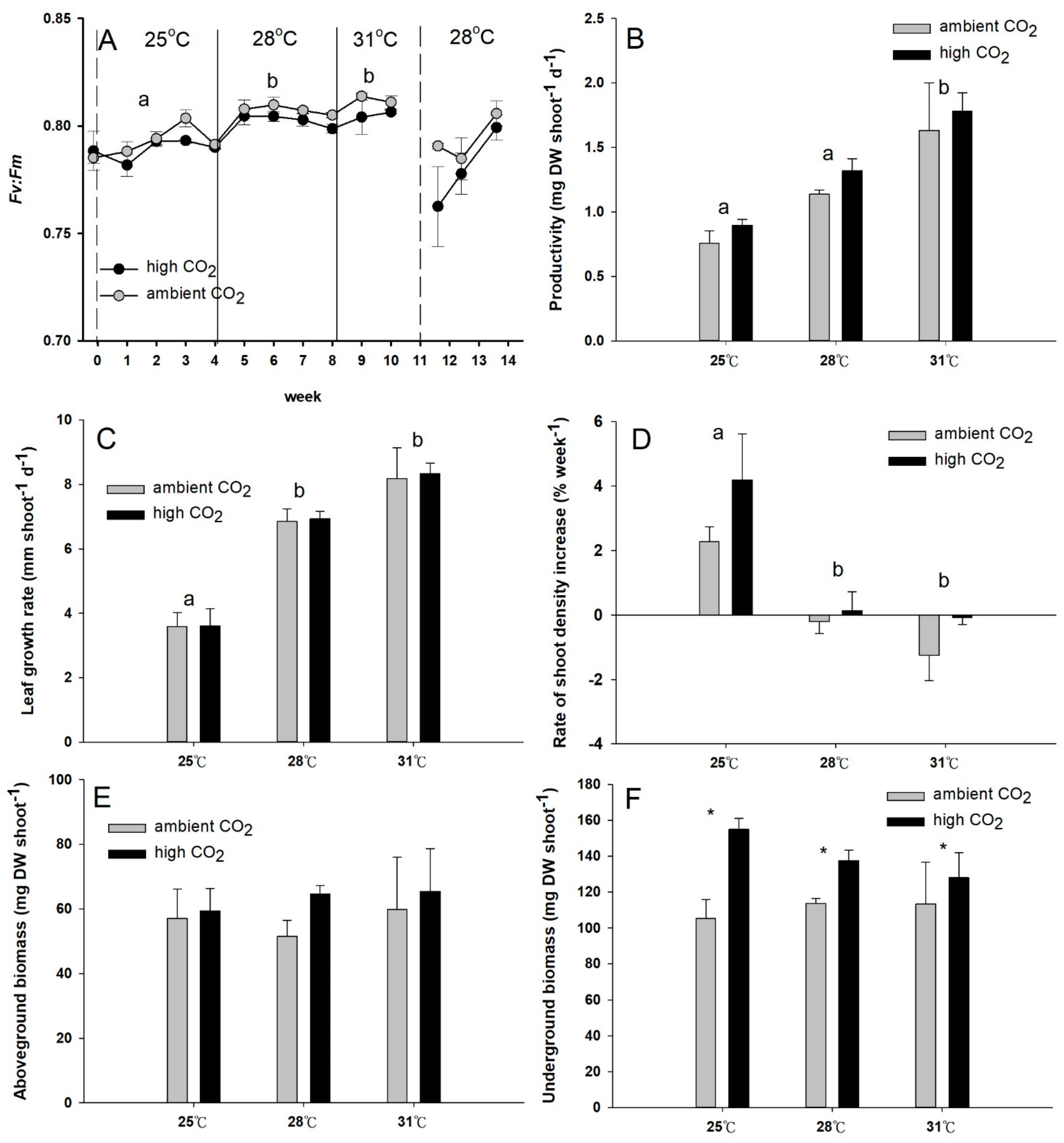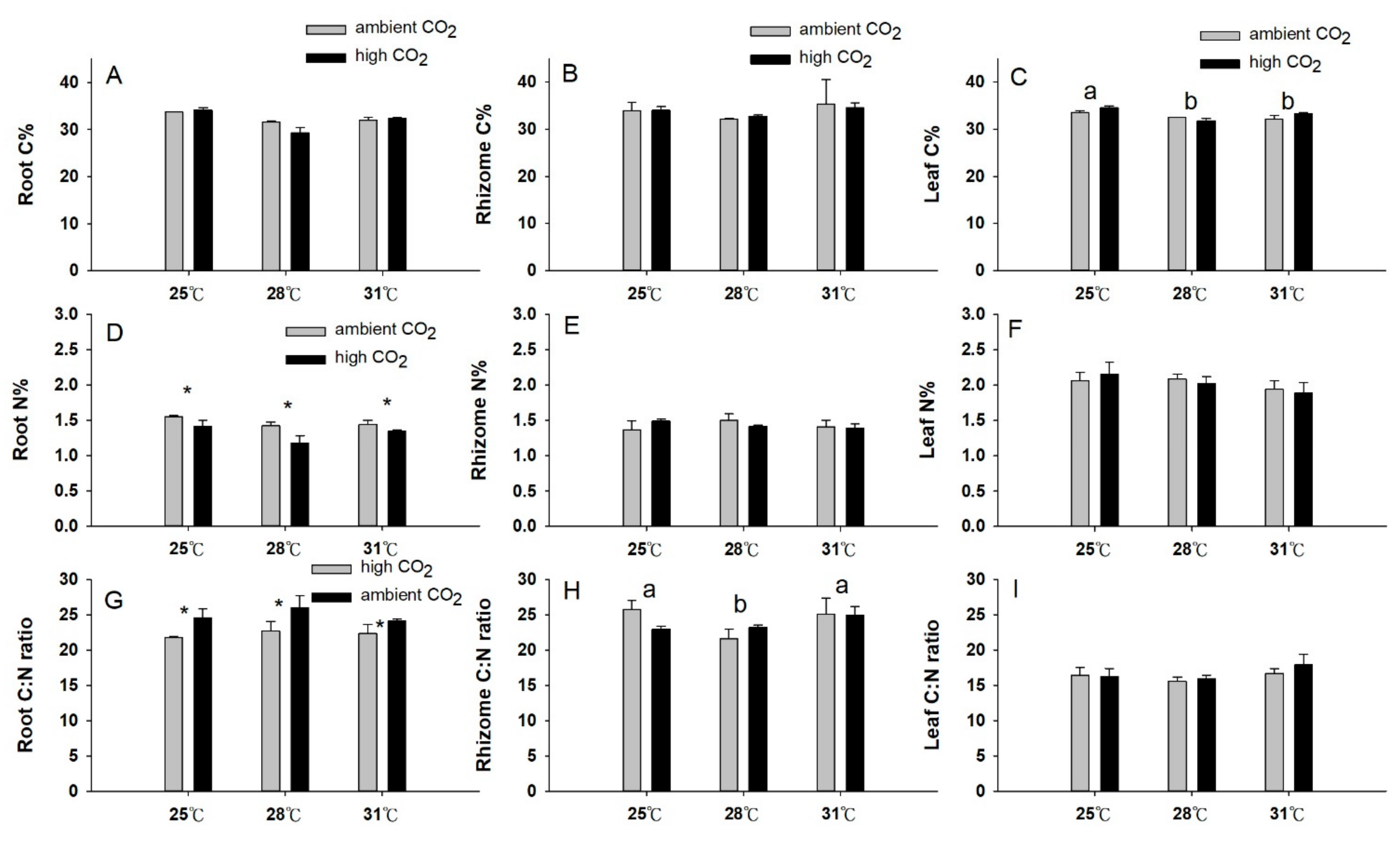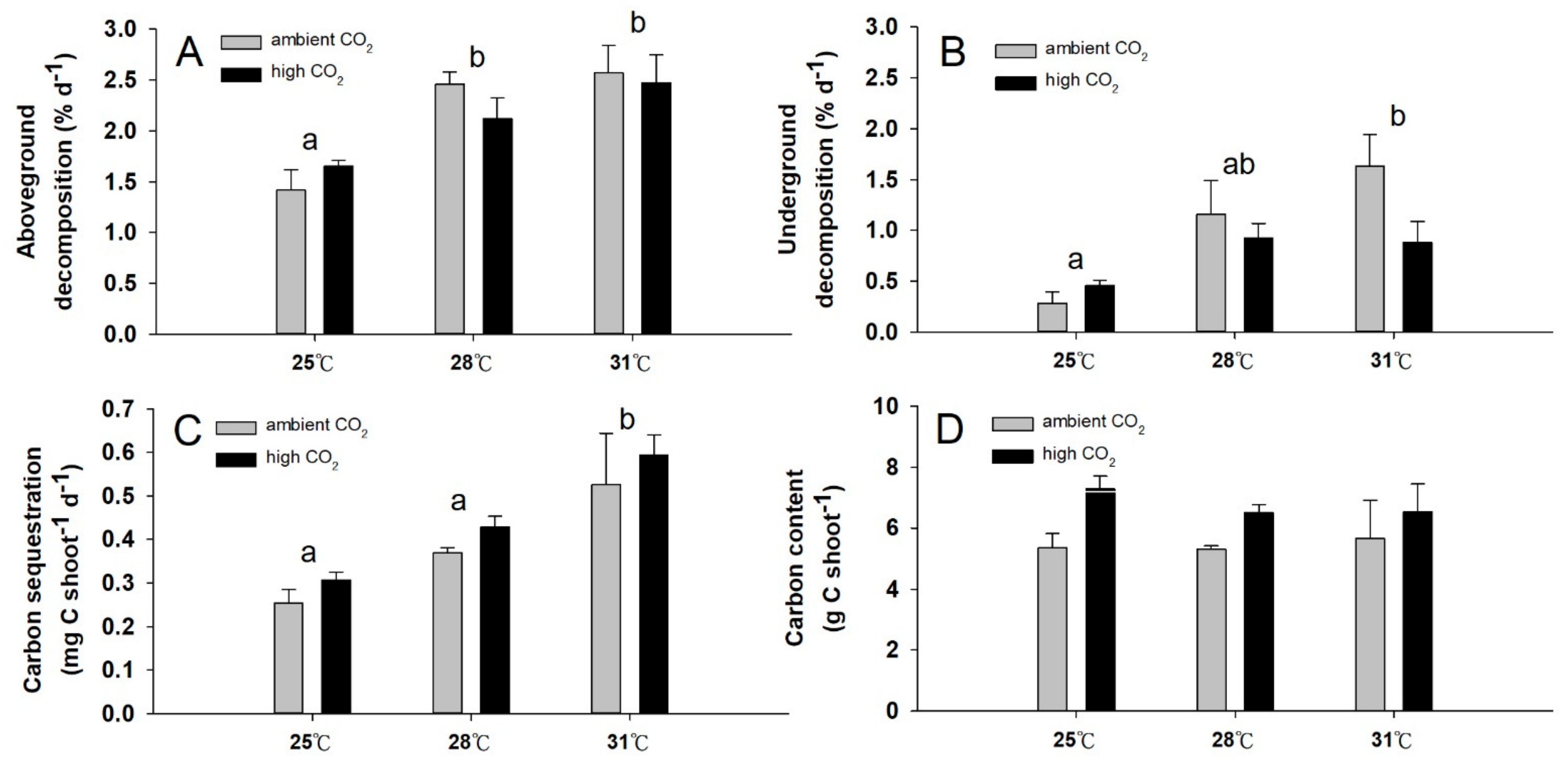Assessing the Effects of Ocean Warming and Acidification on the Seagrass Thalassia hemprichii
Abstract
:1. Introduction
2. Materials and Methods
2.1. Coral Reef Mesocosm Facility
2.2. Seagrass Sampling
2.3. Experimental Design and Manipulation
2.4. Mesocosm Seawater Quality Measurements and Monitoring
2.5. Response Variables
2.6. Data and Statistical Analysis
3. Results
3.1. Photosynthetic Efficiency
3.2. Productivity, Leaf Growth Rate, and Rate of Shoot Density Increase
3.3. Aboveground and Underground Biomass
3.4. Carbon and Nitrogen Content
3.5. Decomposition Rate and Carbon Sequestration
4. Discussion
4.1. The Effects of OA
4.2. The Effects of OW
4.3. The Effects of OA and OW
5. Conclusions
Supplementary Materials
Author Contributions
Funding
Institutional Review Board Statement
Informed Consent Statement
Data Availability Statement
Acknowledgments
Conflicts of Interest
References
- Sabine, C.L.; Feely, R.A.; Gruber, N.; Key, R.M.; Lee, K.; Bullister, J.L.; Wanninkhof, R.; Wong, C.S.; Wallace, D.W.R.; Tilbrook, B.; et al. The oceanic sink for anthropogenic CO2. Science 2004, 305, 367–371. [Google Scholar] [CrossRef] [PubMed] [Green Version]
- Pörtner, H.O. Ecosystem effects of ocean acidification in times of ocean warming: A physiologist’s view. Mar. Ecol. Prog. Ser. 2008, 373, 203–217. [Google Scholar] [CrossRef] [Green Version]
- Van Vuuren, D.P.; Edmonds, J.; Kainuma, M.; Riahi, K.; Thomson, A.; Hibbard, K.; Hurtt, G.C.; Kram, T.; Krey, V.; Lamarque, J.F. The representative concentration pathways: An overview. Clim. Change 2011, 109, 5. [Google Scholar] [CrossRef]
- Stocker, T.F.; Qin, D.; Plattner, G.K.; Alexander, L.V.; Allen, S.K.; Bindoff, N.L.; Bréon, F.M.; Church, J.A.; Cubasch, U.; Emori, S.; et al. Technical Summary. In Climate Change 2013: The Physical Science Basis. Contribution of Working Group I to the Fifth Assessment Report of the Intergovernmental Panel on Climate Change; Stocker, T.F., Qin, D., Plattner, G.K., Tignor, M., Allen, S.K., Boschung, J., Nauels, A., Xia, Y., Bex, V., Midgley, P.M., Eds.; Cambridge University Press: Cambridge, UK; New York, NY, USA, 2013; pp. 33–115. [Google Scholar]
- Smith, S.V. Marine macrophytes as a global carbon sink. Science 1981, 211, 838–840. [Google Scholar] [CrossRef] [Green Version]
- Orr, J.; Pantoia, S.; Pörtner, H.O. Introduction to special section: The Ocean in a high-CO2 world. J. Geophys. Res. 2005, 110, C09S01. [Google Scholar]
- Nellemann, C.; Corcoran, E.; Duarte, C.M.; De Young, C.; Fonseca, L.E.; Grimsdith, G. Blue Carbon: The Role of Healthy Oceans in Binding Carbon; Center for Coastal and Ocean Mapping: Durham, NH, USA, 2010; 80p. [Google Scholar]
- Duarte, C.M.; Chiscano, C.L. Seagrass biomass and production: A reassessment. Aquat. Bot. 1999, 65, 159–174. [Google Scholar] [CrossRef]
- Milena, F.; Simon, B.; Genevieve, M.; David, M. Seagrasses as a sink for wastewater nitrogen: The case of the Adelaide metropolitan coast. Mar. Pollut. Bull. 2009, 58, 303–308. [Google Scholar]
- Fonseca, M.S.; Fisher, J.S. A comparison of canopy friction and sediment movement between four species of seagrass with reference to their ecology and restoration. Mar. Ecol. Prog. Ser. 1986, 29, 15–22. [Google Scholar] [CrossRef]
- Heck, K.L.; Wetstone, G.S. Habitat complexity and invertebrate species richness and abundance in tropical seagrass meadows. J. Biogeogr. 1977, 4, 135–142. [Google Scholar] [CrossRef]
- Nakamura, Y.; Horinouchi, M.; Nakai, T.; Sano, M. Food habits of fishes in a seagrass bed on a fringing coral reef at Iriomote Island, southern Japan. Ichthyol. Res. 2003, 50, 15–22. [Google Scholar] [CrossRef]
- Bell, J.D.; Pollard, D.A. Ecological of fish assemblage and fisheries associated with seagrasses. In Biology of Seagrasses: A Treatise on the Biology of Seagrasses with Special Reference to the Austrealian Region; Aquatic Plant Studies, 2; Larkum, A.W.D., McComb, A.J., Shepherd, S.A., Eds.; Elsevier: Amsterdam, The Netherlands, 1989; pp. 565–609. [Google Scholar]
- Parrish, J.D. Fish communities of interacting shallow-water habitats in tropical oceanic region. Mar. Ecol. Prog. Ser. 1989, 58, 143–160. [Google Scholar] [CrossRef]
- Edgar, G.J.; Shaw, C.; Watson, G.F.; Hammond, L.S. Comparisons of species richness, size-structure and production of benthos in vegetated and unvegetated habitats in Western Port, Victoria. J. Exp. Mar. Biol. Ecol. 1994, 176, 201–226. [Google Scholar] [CrossRef]
- Heck, K.L.; Able, K.W.; Roman, C.T.; Fahay, M.P. Composition, abundance, biomass, and production of macrofauna in a New England estuary: Comparisons among eelgrass meadows and other nursery habitats. Estuaries 1995, 18, 379–389. [Google Scholar] [CrossRef]
- Duffy, J.E. Biodiversity and the functioning of seagrass ecosystems. Mar. Ecol. Prog. Ser. 2006, 311, 233–250. [Google Scholar] [CrossRef] [Green Version]
- Orth, R.J.; Carruthers, T.J.B.; Dennison, W.C.; Duarte, C.M.; Fourqurean, J.W.; Heck, K.L.; Hughes, A.R.; Kendrick, G.A.; Kenworthy, W.J.; Olyarnik, S.; et al. A global crisis for seagrass ecosystems. BioScience 2006, 56, 987–996. [Google Scholar] [CrossRef] [Green Version]
- Gacia, E.; Duarte, C. Sediment retention by a Mediterranean Posidonia oceanica meadow: The balance between deposition and resuspension. Estuar. Coast. Shelf Sci. 2001, 52, 505–514. [Google Scholar] [CrossRef]
- Chiu, S.H.; Huang, Y.H.; Lin, H.J. Carbon budget of leaves of the tropical intertidal seagrass Thalassia hemprichii. Estuar. Coast. Shelf. Sci. 2013, 125, 27–35. [Google Scholar] [CrossRef]
- Laffoley, D.; Grimsditch, G.D. (Eds.) The Management of Natural Coastal Carbon Sinks; IUCN: Gland, Switzerland, 2009; 53p. [Google Scholar]
- Mcleod, E.; Chmura, G.L.; Bouillon, S.; Salm, R.; Björk, M.; Duarte, C.M.; Lovelock, C.E.; Schlesinger, W.H.; Silliman, B.R. A blueprint for blue carbon: Toward an improved understanding of the role of vegetated coastal habitats in sequestering CO2. Front. Ecol. Environ. 2011, 9, 552–560. [Google Scholar] [CrossRef] [Green Version]
- Palacios, S.L.; Zimmerman, R.C. Response of eelgrass Zostera marina to CO2 enrichment possible impacts of climate change and potential for remediation of coastal habitats. Mar. Ecol. Prog. Ser. 2007, 344, 1–13. [Google Scholar] [CrossRef]
- Andersson, A.J.; Mackenzie, F.T.; Gattuso, J.P. Effects of ocean acidification on benthic processes, organisms, and ecosystems. In Ocean Acidification; Gattuso, J.P., Hansson, L., Eds.; Oxford University Press: Oxford, UK, 2011; pp. 122–153. [Google Scholar]
- Egea, L.G.; Jiménez-Ramos, R.; Vergara, J.J.; Hernández, I.; Brun, F.G. Interactive effect of temperature, acidification and ammonium enrichment on the seagrass Cymodocea nodosa. Mar. Pollut. Bull. 2018, 134, 14–26. [Google Scholar] [CrossRef]
- Kroeker, K.J.; Kordas, R.L.; Crim, R.N.; Singh, G.G. Meta-analysis reveals negative yet variable effects of ocean acidification on marine organisms. Ecol. Lett. 2010, 13, 1419–1434. [Google Scholar] [CrossRef] [PubMed]
- Allison, A. The influence of species diversity and stress intensity on community resistance and resilience. Ecol. Monogr. 2004, 74, 117–134. [Google Scholar] [CrossRef]
- Mukai, H. Biogeography of the tropical seagrass in the western Pacific. Aust. J. Mar. Freshwater Res. 1993, 44, 1–17. [Google Scholar] [CrossRef]
- Liu, P.J.; Lin, S.M.; Fan, T.Y.; Meng, P.J.; Shao, K.T.; Lin, H.J. Rates of overgrowth by macroalgae and attack by sea anemones are greater for live coral than dead coral under conditions of nutrient enrichment. Limnol. Oceanogr. 2009, 54, 1167–1175. [Google Scholar] [CrossRef]
- Liu, P.J.; Hsin, M.C.; Huang, Y.H.; Fan, T.Y.; Meng, P.J.; Lu, C.C.; Lin, H.J. Nutrient enrichment coupled with sedimentation favors sea anemones over corals. PLoS ONE. 2015, 10, e0125175. [Google Scholar] [CrossRef]
- Vermaat, J.E.; Agawin, N.S.R.; Duarte, C.M.; Fortes, M.D.; Marbà, N.; Uri, J.S. Meadow maintenance, growth and productivity in a mixed Philippine seagrass bed. Mar. Ecol. Prog. Ser. 1995, 124, 215–225. [Google Scholar] [CrossRef]
- Lin, H.J.; Shao, K.T. Temporal changes in the abundance and growth of intertidal Thalassia hemprichii seagrass beds in southern Taiwan. Bot. Bull. Acad. Sin. 1998, 39, 191–198. [Google Scholar]
- Lewis, E.; Wallace, D. Program Developed for CO2 System Calculations; USA. 1998; 40p. Available online: https://www.osti.gov/dataexplorer/biblio/dataset/1464255 (accessed on 2 April 2022).
- Mehrbach, C.; Culberson, C.H.; Hawley, J.E.; Pytkowitz, R.M. Measurement of the apparent dissociation constants of carbonic acid in seawater at atmospheric pressure. Limnol. Oceanogr. 1973, 18, 897–907. [Google Scholar] [CrossRef]
- Dickson, A.G.; Millero, F.J. A comparison of the equilibrium constants for the dissociation of carbonic acid in seawater media. Deep Sea Res. Part A 1987, 34, 1733–1743. [Google Scholar] [CrossRef]
- Lee, K.-S.; Dunton, K.H. Production and carbon reserve dynamics of the seagrass Thalassia testudinum in Corpus Christi Bay, Texas, USA. Mar. Ecol. Prog. Ser. 1996, 143, 201–210. [Google Scholar] [CrossRef]
- Mayfield, A.B.; Chen, M.; Meng, P.J.; Lin, H.J.; Chen, C.S.; Liu, P.J. The physiological response of the reef coral Pocillopora damicornis to elevated temperature: Results from coral reef mesocosm experiments in Southern Taiwan. Mar. Environ. Res. 2013, 86, 1–11. [Google Scholar] [CrossRef] [PubMed]
- Pai, S.C.; Yang, C.C.; Riley, J.P. Effects of acidity and molybdate concentration on the kinetics of the formation of the phosphoantimonyl molybdenum blue complex. Anal. Chim. Acta 1990, 229, 115–120. [Google Scholar]
- Pai, S.C.; Riley, J.P. Determination of nitrate in the presence of nitrite in natural waters by flow injection analysis with a non-quantitative on-line cadmium reductor. Int. J. Environ. Anal. Chem. 1994, 57, 263–277. [Google Scholar] [CrossRef]
- Strickland, J.D.H.; Parsons, T.R. A Practical Handbook of Seawater Analysis, 2nd ed.; Fisheries Research Board of Canada Bulletin; The Alger Press Ltd.: Ottawa, ON, Canada, 1972; 328p. [Google Scholar]
- Short, F.T.; Duarte, C.M. Methods for the measurement of seagrass growth and production. In Global Seagrass Research Methods; Short, F.T., Coles, R.G., Eds.; Elsevier Science: Amsterdam, The Netherlands, 2001; pp. 155–182. [Google Scholar]
- Mateo, M.A.; Romero, J. Evaluating seagrass leaf litter decomposition: An experimental comparison between litter-bag and oxygen-uptake methods. J. Exp. Mar. Biol. Ecol. 1996, 202, 97–106. [Google Scholar] [CrossRef]
- Peterson, R.C.; Cummins, K.W. Leaf processing in a woodland stream. Freshw. Biol. 1974, 4, 343–368. [Google Scholar] [CrossRef]
- Buapet, P.; Rasmusson, L.M.; Gullström, M.; Björk, M. Photorespiration and carbon limitation determine productivity in temperate seagrasses. PLoS ONE. 2013, 8, e83804. [Google Scholar] [CrossRef] [Green Version]
- Invers, O.; Romero, J.; Pérez, M. Effects of pH on seagrass photosynthesis: A laboratory and field assessment. Aquat. Bot. 1997, 59, 185–194. [Google Scholar] [CrossRef]
- Invers, O.; Perez, M.; Romero, J. Bicarbonate utilization in seagrass photosynthesis: Role of carbonic anhydrase in Posidonia oceanica (L.) Delile and Cymodocea nodosa (Ucria) Ascherson. J. Exp. Mar. Biol. Ecol. 1999, 235, 125–133. [Google Scholar] [CrossRef]
- Invers, O.; Zimmerman, R.C.; Alberte, R.S.; Pérez, M.; Romero, J. Inorganic carbon sources for seagrass photosynthesis: An experimental evaluation of bicarbonate use in species inhabiting temperate waters. J. Exp. Mar. Biol. Ecol. 2001, 265, 203–217. [Google Scholar] [CrossRef]
- Zimmerman, R.C.; Kohrs, D.G.; Steller, D.L.; Alberte, R.S. Impacts of CO2 enrichment on productivity and light requirements of eelgrass. Plant Physiol. 1997, 115, 599–607. [Google Scholar] [CrossRef] [Green Version]
- Vizzini, S.; Tomasello, A.; Maida, G.D.; Pirrotta, M.; Mazzola, A.; Calvo, S. Effect of explosive shallow hydrothermal vents on δ13C and growth performance in the seagrass Posidonia oceanica. J. Ecol. 2010, 98, 1284–1291. [Google Scholar] [CrossRef]
- Russell, B.D.; Connell, S.D.; Uthicke, S.; Muehllehner, N.; Fabricius, K.E.; Hall-Spencer, J.M. Future seagrass beds: Can increased productivity lead to increased carbon storage? Mar. Pollut. Bull. 2013, 73, 463–469. [Google Scholar] [CrossRef] [Green Version]
- Apostolaki, T.E.; Vizzini, S.; Hendriks, I.E.; Olsen, Y.S. Seagrass ecosystem response to long-term high CO2 in a Mediterranean volcanic vent. Mar. Environ. Res. 2014, 99, 9–15. [Google Scholar] [CrossRef] [PubMed] [Green Version]
- Jiang, Z.J.; Huang, X.P.; Zhang, J.P. Effects of CO2 enrichment on photosynthesis, growth, and biochemical composition of seagrass Thalassia hemprichii (Ehrenb.) Aschers. J. Integr. Plant. Biol. 2010, 52, 904–913. [Google Scholar] [CrossRef]
- Ooi, J.L.S.; Kendrick, G.A.; Niel, P.V. Effects of sediment burial on tropical ruderal seagrasses are moderated by clonal integration. Cont. Shelf. Res. 2011, 31, 1945–1954. [Google Scholar] [CrossRef]
- Alexandre, A.; Silva, J.; Buapet, P.; Björk, M.; Santos, R. Effects of CO2 enrichment on photosynthesis, growth, and nitrogen metabolism of the seagrass Zostera noltii. Ecol. Evol. 2012, 2, 2625–2635. [Google Scholar] [CrossRef] [PubMed]
- Campbell, J.E.; Fourqurean, J.W. Mechanisms of bicarbonate use influence the photosynthetic carbon dioxide sensitivity of tropical seagrasses. Limnol. Oceanogr. 2013, 58, 839–848. [Google Scholar] [CrossRef]
- Liu, P.J.; Ang, S.J.; Mayfield, A.B.; Lin, H.J. Influence of the seagrass Thalassia hemprichii on coral reef mesocosms exposed to ocean acidification and experimentally elevated temperature. Sci. Total Environ. 2020, 700, 133464. [Google Scholar] [CrossRef]
- Perez, M.; Romero, J. Photosynthetic response to light and temperature of the seagrass Cymodocea nodosa and the prediction of its seasonality. Aquat. Bot. 1992, 43, 51–62. [Google Scholar] [CrossRef]
- Marbà, N.; Duarte, C.M. Mediterranean warming triggers seagrass (Posidonia oceanica) shoot mortality. Glob. Change. Biol. 2010, 16, 2366–2375. [Google Scholar] [CrossRef]
- Thomson, J.A.; Burkholder, D.A.; Heithaus, M.R.; Fourqurean, J.W.; Fraser, M.W.; Statton, J.; Kendrick, G.A. Extreme temperatures, foundation species, and abrupt ecosystem change: An example from an iconic seagrass ecosystem. Glob. Change Biol. 2015, 21, 1463–1474. [Google Scholar] [CrossRef] [PubMed]
- Smale, D.A.; Wernberg, T. Extreme climatic event drives range contraction of a habitat-forming species. Proc. R. Soc. B 2013, 280, 20122829. [Google Scholar] [CrossRef] [PubMed]
- Lee, K.S.; Park, S.R.; Kim, Y.K. Effects of irradiance, temperature, and nutrients on growth dynamics of seagrasses: A review. J. Exp. Mar. Biol. Ecol. 2007, 350, 144–175. [Google Scholar] [CrossRef]
- Short, F.T.; Neckles, H.A. The effects of global climate change on seagrasses. Aquat. Bot. 1999, 63, 169–196. [Google Scholar] [CrossRef]
- Kirschbaum, M.U.F. The temperature dependence of soil organic matter decomposition, and the effect of global warming on soil organic C storage. Soil. Biol. Biochem. 1995, 27, 753–760. [Google Scholar] [CrossRef]
- Huang, Y.H.; Lee, C.L.; Chung, C.Y.; Hsiao, S.C.; Lin, H.J. Carbon budgets of multispecies seagrass beds at Dongsha Island in the South China Sea. Mar. Environ. Res. 2015, 106, 92–102. [Google Scholar] [CrossRef]
- Mazarrasa, I.; Samper-Villarreal, J.; Serrano, O.; Lavery, P.S.; Lovelock, C.E.; Marbà, N.; Duarte, C.M.; Cortés, J.A. Habitat characteristics provide insights of carbon storage in seagrass meadows. Mar. Pollut. Bull. 2018, 134, 106–117. [Google Scholar] [CrossRef]




| Response Variable | CO2 | Week(Temp.) | Temp. | Temp. × CO2 | |
|---|---|---|---|---|---|
| Degrees of freedom (df)-Fv:Fm | 1 | 8 | 2 | 2 | |
| df-all other response variables | 1 | 3 | 2 | 2 | |
| Source of variation | Exact F statistics | Figure | |||
| Fv:Fm | 2.96 | 3.64 | 32.1 *** | 2.01 | 2A |
| Productivity (mg DW shoot−1 day−1) | 0.84 | 99.90 ** | 0.09 | 2B | |
| Leaf growth rate (mm shoot−1 day−1) | 0.08 | 24.10 * | 0.002 | 2C | |
| Rate of shoot density increase (% week−1) | 4.06 | 10.06 * | 0.35 | 2D | |
| Aboveground biomass (mg DW shoot−1) | 0.35 | 0.14 | 0.68 | 2E | |
| Underground biomass (mg DW shoot−1) | 14.90 * | 0.12 | 1.07 | 2F | |
| U/A ratio | 1.47 | 1.05 | 3.99 | NP | |
| Root carbon percentage | 1.35 | 8.39 | 1.40 | 3A | |
| Rhizome carbon percentage a | 1.04 | 2.23 | 0.04 | 3B | |
| Leaf carbon percentage | 1.64 | 32.70 ** | 10.72 * | 3C | |
| Root nitrogen percentage | 16.30 * | 2.01 | 0.43 | 3D | |
| Rhizome nitrogen percentage | 0.27 | 0.17 | 0.46 | 3E | |
| Leaf nitrogen percentage | 0.005 | 9.47 | 2.35 | 3F | |
| Root C:N ratio | 10.25 * | 0.30 | 0.20 | 3G | |
| Rhizome C:N ratio | 0.16 | 21.60 * | 7.10 | 3H | |
| Leaf C:N ratio | 0.14 | 3.67 | 1.65 | 3I | |
| Aboveground decomposition (% d−1) | 2.20 | 28.90 * | 3.53 | 4A | |
| Underground decomposition (% d−1) | 4.03 | 15.10 * | 3.14 | 4B | |
| Carbon sequestration (mg C shoot−1 d−1) | 1.25 | 160.20 *** | 0.10 | 4C | |
| Shoot carbon content (g C shoot−1) | 4.57 | 0.66 | 0.39 | 4D | |
Publisher’s Note: MDPI stays neutral with regard to jurisdictional claims in published maps and institutional affiliations. |
© 2022 by the authors. Licensee MDPI, Basel, Switzerland. This article is an open access article distributed under the terms and conditions of the Creative Commons Attribution (CC BY) license (https://creativecommons.org/licenses/by/4.0/).
Share and Cite
Liu, P.-J.; Chang, H.-F.; Mayfield, A.B.; Lin, H.-J. Assessing the Effects of Ocean Warming and Acidification on the Seagrass Thalassia hemprichii. J. Mar. Sci. Eng. 2022, 10, 714. https://doi.org/10.3390/jmse10060714
Liu P-J, Chang H-F, Mayfield AB, Lin H-J. Assessing the Effects of Ocean Warming and Acidification on the Seagrass Thalassia hemprichii. Journal of Marine Science and Engineering. 2022; 10(6):714. https://doi.org/10.3390/jmse10060714
Chicago/Turabian StyleLiu, Pi-Jen, Hong-Fong Chang, Anderson B. Mayfield, and Hsing-Juh Lin. 2022. "Assessing the Effects of Ocean Warming and Acidification on the Seagrass Thalassia hemprichii" Journal of Marine Science and Engineering 10, no. 6: 714. https://doi.org/10.3390/jmse10060714







